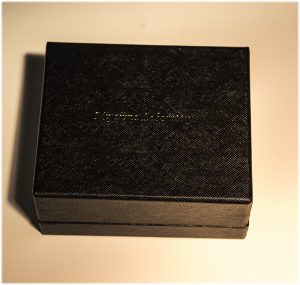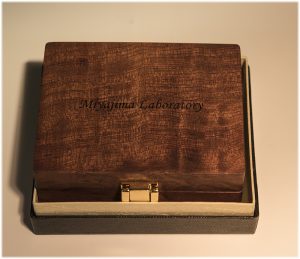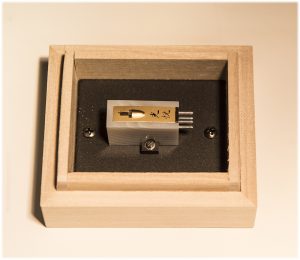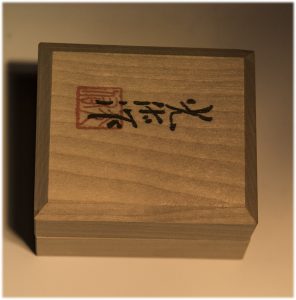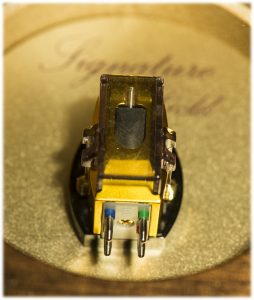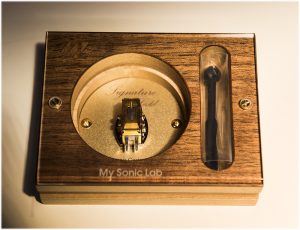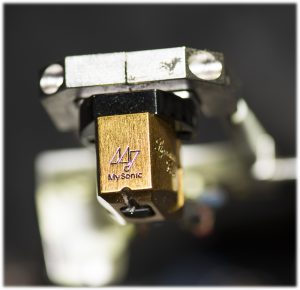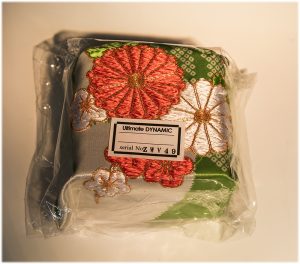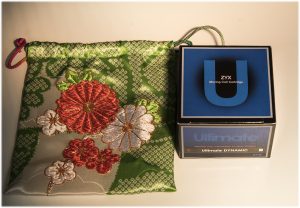English Translation below German Text
Gestern war ein ganz besonderer Tag! Ich hatte die Möglichkeit 4 Top-Tonabnehmer an meiner Anlage im Vergleich anzuhören!
Hintergrund war, dass ich ja ein Lyra Atlas und ein Audio Technica Art 1000 bei mir verwende und gern ein System hätte, welches die Vorzüge der Beiden in sich vereinigt!
Wer jetzt einen richtig objektiven Test erwartet, den muss ich enttäuschen: Insgesamt stand ja nur ein Tag zur Verfügung – in 11 Stunden 4 Tonabnehmer justieren und anhören kann nicht perfekt sein. Hinzu kam, dass das Sonic Lab Signature Gold und das Koetsu Onyx Platinium fabrikneu und nicht eingespielt waren. Angehört wurde mit meiner großen Anlage, die natürlich auch nicht der „gängigen Norm“ entspricht…
Kurzbeschreibung:
– Plattenspieler: Prototyp des Caeles Laufwerks mit eigenem luftgelagertem Drehtonarm
– Phonovorstufe: GECOM-Technologies Röhrenvorstufe mit externem Netzteil
– Vorstufe: GECOM-Technologies Line Stage, natürlich auch in Röhrentechnik.
– Endstufe Bass: TB3/1000 single ended Triode
– Endstufe Mittel- /Hochtonbereich: 845 single ended Triode
– Basshorn : Chassis (Field coil) von Wolf von Langa
– Mittelton : Sonderanfertigung mit Kugelwellenhorn
– Hochton: TAD 2001 mit Kugelwellenhorn (die neuen Karlson Coupler aus Bronze waren leider noch nicht fertig)
– Superhochton : 25mm Diamantkalotte von Thiel
– Sehr umfangreiche Stromaufbereitung
Der Raum ist akustisch so weit wie möglich optimiert und die Anlage ist über die Jahre in allen Komponenten optimiert und abgestimmt worden.
Zuerst hörten wir mit dem Lyra Atlas – nur um den „Ist-Zustand“ festzustellen. Das Atlas war natürlich gut justiert und eingespielt und zeigte seine bekannten Vorzüge – insbesondere was Dynamik und Auflösung angeht.
Der erste Tonabnehmer der dann montiert wurde, war das Miyajima Laboratories Destiny
Dieser Tonabnehmer hat einen Nadelträger aus einem Kaktus-Stachel und das Ringmagnetsystem.
16 Ohm Impedanz, Ausgangsspannung 0,23mV, geeignet für eher schwere Tonarme.
Durch den völlig verrundeten Körper aus African Blackwood etwas schwieriger zu justieren. Nach der mechanischen Justage wurde das System kurz auf seine elektrische Performance überprüft – keine besonderen Auffälligkeiten, messtechnisch so die übliche Performance von japanischen MC-Systemen.
Die klangliche Beschreibung ist etwas schwierig – im Grunde kann ich nur Tendenzen in meinem System nennen, das ja auf von der Charakteristik auf völlig andere Tonabnehmer optimiert ist. Zusätzlich die begrenzte Zeit für Justage und Anhören. Will es mal so formulieren: Für Platten ab so ca. 1980 – also z.B. Originalpressung Pink Floy „the Wall“, Rickie Lee Jones „Pirates“ etc, paßte es einfach nicht bei meinem set up – zu füllig, zu wenig Kontur im Baß, zu wenig Auflösung, zu wenig Dynamik – auf der anderen Seite aber sehr harmonisch und ausgewogen. Ein ganz anderes Bild zeigte sich bei älteren Pressungen – z.B. Ike & Tina Turner, „Live in Paris 1972“ – das war wie wenn ein gutes Objektiv genau fokussiert! Erster spontaner Eindruck: Das passt – aber richtig! Meine Einschätzung: Wer gerne oder ausschließlich ältere Aufnahmen hört ist mit diesem System sehr gut bedient!
Danach wurde die Anlage heruntergefahren, damit alle Systeme unter den gleichen Bedingungen gehört werden konnten.
Das nächste System war das Koetzu Onyx Platinium.
Der Tonabnehmerkörper in der typischen Koetsu-Form aber aus Onyx. Als Besonderheit die Platin-Magnete und versilberte Kupferspulen. Durch die Gehäuseform ist die mechanische Justage natürlich viel einfacher. Messtechnisch konnte das System schon mal gut überzeugen: Kanaltrennung im Bereich von 30 dB und auch sonst sehr gute Messwerte. Ausgangsspannung 0,3mV, Impedanz nicht angegeben – ich schätze in der Größenordnung 20 Ohm.
Ich kannte ja von früher noch Koetsu Black und Rosewood die waren in den Mitten sehr gut, aber beim Rest fehlte mir Einiges…
Jetzt das Koetsu Onyx war etwas ganz anderes – das passte in meiner Anlage auf Anhieb, ok das ist noch untertrieben – das passte ganz ausgezeichnet!!!
Räumlichkeit, Auflösung, Dynamik alles da und wirklich ausgezeichnet! Ich neige bestimmt nicht zu Übertreibungen, aber Stimmen und Mitteltonbereich waren zum Niederknien! Was mir (und auch den beiden anderen Zuhörern gleichsam) aufgefallen ist: Wenn das jeweilige Teststück fertig war, hatte man eigentlich noch Lust, die Platte weiterlaufen zu lassen!
So sollte ein Tonabnehmer sein: Man wird emotional von der Musik mitgenommen und die Wiedergabe ist sehr nah an „perfekt“. Bitte beachten: Das System war noch nicht mal eingespielt!
Ja, es funktionierte bei allen der ausgewählten Testplatten, egal ob 80er, älter oder ganz neue Aufnahmen gleich gut.
Mein Fazit: Der schon immer vorhandene sehr gute Mitteltonbereich nochmals verbessert und die Schwächen von früher, völlig beseitigt. Ganz große Empfehlung meinerseits!
Erneut die Prozedur des Umbaus und natürlich wieder Herunterfahren der Anlage.
Der nächste Kandidat war das My Sonic Lab Signature Gold.
Das My Sonic Lab Signature Gold hat die niedrigste Impedanz von 1,4 Ohm(!) und dabei die höchste Ausgangsspannung von 0,5 mV. Ich glaube ich brauche nicht extra zu erwähnen, dass für alle Systeme die Lautstärke für die Hörtests gleich eingestellt wurde.
Messtechnisch hat mich das My Sonic Lab positiv überrascht: Auf Anhieb eine Kanaltrennung von mehr als 37 dB! Das ist der bisher beste Wert, den ich hier gemessen habe. Durch die Gehäuseform und gute Sicht auf den Nadelträger ist das System sehr einbaufreundlich.
Ich hatte von diesem Hersteller bisher noch nichts unter aussagekräftigen Bedingungen gehört. Wie gesagt, das System war fabrikneu. Die ersten paar Minuten des Hörtests verliefen etwas zwiespältig: Einerseits hatte ich sofort für mich selbst den Eindruck, es wäre das System, welches technisch am besten reproduziert, aber ein paar Bereiche stimmten nicht. So war z.B. der Bass ein wenig unkontrolliert. Aber nach ca. ½ Stunde Spielzeit wurde das System immer besser! Es stimmte einfach alles. Feinste Details wurden aufgeschlüsselt (Klar die höhere Ausgangsspannung führt automatisch zu einem besseren Fremdspannungsabstand!) In den Bereichen Dynamik, Auflösung, Räumlichkeit, Macro und Micro-Dynamik übertraf es sogar das Koetsu Onyx! Was Störgeräusche, wie das Rillengeräusch und die pops und klicks von feinen Kratzern anging, war es eindeutig das ruhigste aller getesteten Systeme. Ich gehe davon aus, dass es nach etwas mehr Einspielzeit auch die Qualität der Stimmen vom Koetsu Onyx erreichen wird. Über alles gesehen passte dieses System so was von gut in meine Anlagenkonfiguration, dass ich nicht wiederstehen konnte! Wie es bei sterophile manchmal so schön am Ende von einem Test steht: „bought the review sample“!
Für mich selber in meiner speziellen Konfiguration komme ich damit deutlich weiter – weit genug, um den nicht gerade niedrigen Anschaffungspreis zu rechtfertigen.
Der letzte Kandidat war dann das Zyx Ultimate Dynamic.
Hier gibt es technologisch einige Neuerungen: Nadelträger und Spulenkern sind aus Carbon, genauso die Anschlussplatte für die Pins. Das System hat mit 0,15mV die geringste Ausgangsspannung (obwohl es sich deutlich lauter anhörte) Impedanz 12 Ohm, eher für mittelschwere als schwere Arme geeignet. Messtechnisch auch auf hohem Niveau.
Zum Glück ist meine Kette sehr störungsarm – so war auch die geringere Ausgangsspannung kein Problem.
Schon in der Einlaufrille des ersten Teststücks fielen zwei Dinge auf: Das Rillengeräusch wurde in einem 180° Halbkreis abgebildet und es war lauter als bei den anderen 3 bisher getesteten System. Anmerkung hierzu: Das Rillen-Laufgeräusch ist ja rein zufällig – somit ist eine 180° Abbildung das theoretische Optimum. In meiner Anlage sind 150° der Normalzustand.
Die Räumlichkait war somit sehr beeindruckend – die bisher breiteste Abbildung – vergleichbar Cinemascope! Die Dynamik war auch auf hohem Niveau. Im ersten Moment war das System sehr beeindruckend! Bei etwas längerem Hören empfand ich es aber als etwas übertrieben und Effekthascherisch! Wirkte auf mich irgendwie etwas unnatürlich…
Typischer Fall von „passt nicht“
Damit mich wirklich keiner falsch versteht: Der Sinn des Tests war, herauszufinden, welches System, wenn überhaupt eines, von der Charakteristik gut zu meiner bestehenden Anlage passen würde. Ich mache also keinerlei Aussagen über die objektive Qualität der einzelnen Probanden. In einer anderen Konfiguration käme es vermutlich zu anderen Ergebnissen.
Auch ist die Auswahl und Wahrnehmung von egal wie gespeicherter Musik eine völlig subjektive Angelegenheit. Da muss jeder für sich selbst herausfinden, welche Kombination von Kompromissen für Ihn die beste Lösung ist.
Ich bin sehr froh, die Möglichkeiten für diesen Vergleich gehabt zu haben. Nachdem das My Sonic Lab eingespielt ist, werde ich noch einmal berichten.
Alle getesteten Tonabnehmer sind natürlich auch neu bei mir erhältlich. Einbau und Justage führe ich auch auf Wunsch durch.
English translation
Yesterday was a very special day! I had the opportunity to compare 4 top pickups on my system!
The background was that I am using a Lyra Atlas and an Audio Technica Art 1000 and would like a system that combines the advantages of both!
If you now expect a really objective test, I have to disappoint you: Overall, there was only one day available – adjusting and listening to 4 pickups in 11 hours cannot be perfect. In addition, the Sonic Lab Signature Gold and Koetsu Onyx Platinium were brand new and not run in. We listened to my large system, which of course does not meet the „current standard“ …
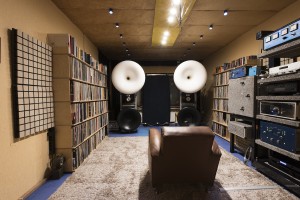
Short description:
– Turntable: Prototype of the Caeles turntable with its own air-bearing pivoted arm
– Phono preamplifier: GECOM-Technologies tube preamplifier with external power supply
– Preliminary stage: GECOM-Technologies Line Stage, of course also in tube technology.
– Bass amplifier: TB3 / 1000 single ended triode
– Mid / high range amplifier: 845 single ended triode
– Basshorn: Chassis (Field coil) by Wolf von Langa
– Mid-range: custom-made compression driver with spherical LeCleach horn
– Tweeter: TAD 2001 with spherical LeCleach horn (unfortunately the new Karlson couplers made of bronze were not yet finished)
– Supertweeter: 25mm diamond dome from Thiel
– Very extensive power processing
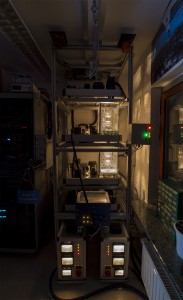
The room is acoustically optimized as much as possible and the system has been optimized and tweaked in all components over the years.
At first we listened with the Lyra Atlas – only to determine the „current state“. The Atlas was of course well adjusted and run in so it showed its well-known advantages – especially in terms of dynamics and resolution.
The first cartridge that was then assembled was the Miyajima Laboratories Destiny
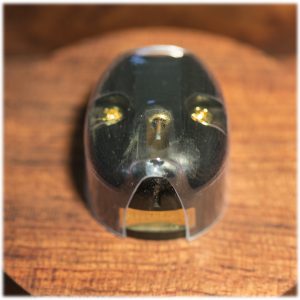
Miyamjima Lab
This cartridge has a needle carrier made from a cactus spike and the ring magnet system.
16 ohm impedance, output voltage 0.23mV, suitable for heavy tonearms.
A little more difficult to adjust due to the completely rounded body made of African Blackwood. After the mechanical adjustment, the system was briefly checked for its electrical performance – no particular abnormalities, in terms of measurements performance the usual of Japanese MC systems.
The sound description is a bit difficult – basically I can only name tendencies in my system, which is optimized on the characteristics of completely different pickups. In addition, the limited time for adjustment and listening. To put it this way: For records from around 1980 or so – e.g. Original pressing Pink Floy „the Wall“, Rickie Lee Jones „Pirates“ etc., it just didn’t fit my set up – too full, too little contour in the bass, too little resolution, too little dynamics – on the other hand very harmonious and balanced. A completely different picture emerged with older pressings – e.g. Ike & Tina Turner, „Live in Paris 1972“ – it was like when a good lens was focused precisely! First spontaneous impression: That fits – but completely! My assessment: Anyone who likes to hear or only listen to older recordings is very well served with this system!
The system was then shut down so that all systems could be heard under the same conditions.
The next system was the Koetzu Onyx Platinium.
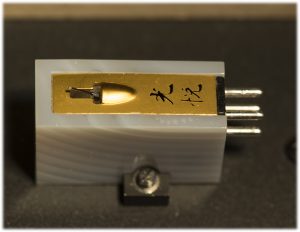
Koetsu Onyx Platinum
The cartridge body is done in the typical Koetsu shape but made of onyx. A special features are to name, the platinum magnets and silver-plated copper coils. Due to the shape of the housing, mechanical adjustment is of course much easier. From a measurement point of view, the system was convincing: Channel separation in the range of 30 dB and other very good measured values. Output voltage 0.3mV, impedance not specified – I estimate in the order of 20 ohms.
I knew Koetsu Black and Rosewood from the past, they were very good in the midrange, especially voices, but I was missing a lot from the rest …
Now the Koetsu Onyx was something completely different – that fit in my system straight away, ok that’s still an understatement – it fit very well !!!
Spatiality, resolution, dynamic everything there and really excellent! I’m not prone to exaggeration, but voices and midrange were for kneeling down! What struck me (and also the other two listeners, as it were): When the respective test piece was finished, you actually wanted to let the record continue to run!
This is how a pickup should be: You are emotionally carried away by the music and the reproduction is very close to „perfect“. Please note: the system was not even run in!
Yes, it worked equally well with all of the selected test plates, whether 80s, older or completely new recordings.
My conclusion: The already very good mid-range has been improved again and the weaknesses of the past have been completely eliminated. Very big recommendation on my part!
Again the procedure of the conversion and of course shutdown of the rig.
The next candidate was the My Sonic Lab Signature Gold.
My Sonic Lab Signature Gold
The My Sonic Lab Signature Gold has the lowest impedance of 1.4 ohms (!) And the highest output voltage of 0.5 mV. I don’t think I need to mention that the volume for the hearing tests was set the same for all systems.
In terms of measurement technology, the My Sonic Lab surprised me positively: straight away a channel separation of more than 37 dB! This is the best value I have ever measured here. Thanks to the shape of the housing and a good view of the needle carrier, the system is very easy to install.
I had never heard of this manufacturer under meaningful conditions. As I said, the system was brand new. The first few minutes of the hearing test were somewhat ambiguous: on the one hand, I immediately had the impression for myself that it was the system that reproduced the best way technically, but a few areas were not correct. For example, the bass a bit uncontrolled. But after about half an hour of play, the system got better and better! Everything was just right. The finest details were broken shown (Clearly the higher output voltage automatically leads to a better signal noise ratio) In the areas of dynamics, resolution, spatiality, macro and micro-dynamics, it even exceeded the Koetsu Onyx! When it came to noise, such as the groove noise and the pops and clicks of fine scratches, it was clearly the quietest of all systems tested. I assume that after a little more warm-up time it will also achieve the quality of the voices from Koetsu Onyx. Overall, this system fit so well into my system configuration that I couldn’t resist! As it sometimes is written at the end of a test with sterophile: „bought the review sample“!
For myself in my special configuration, I get a lot further – far enough to justify the not exactly low purchase price.
The last candidate was the Zyx Ultimate Dynamic.
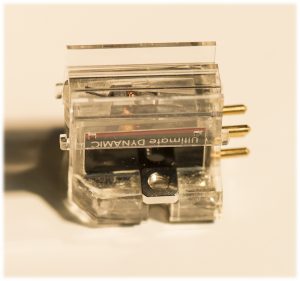
Zyx Ultimate Dynamic
Technologically, there are some real innovations here: the needle carrier and coil core are made of carbon, as is the connection plate for the pins. At 0.15mV, the system has the lowest output voltage (although it sounded a lot louder), impedance 12 ohms, more suitable for medium-weight than heavy-weight arms. Measured performance was also at a high level.
Fortunately, my chain is very quiet – so the lower output voltage was not a problem.
Already in the inlet groove of the first test record two things were noticed: the groove noise was reproduced in a 180 ° semicircle and it was louder than the other 3 systems tested so far. Note on this: The groove running noise is purely coincidental – so a 180 ° image is the theoretical optimum. In my system, 150 ° is the normal state.
The spatial reproduction was very impressive – the widest picture ever – comparable to Cinemascope! The dynamics was also at a high level. At first the system was very impressive! When I listened a little longer, I found it a bit exaggerated and showy! Somehow seemed a bit unnatural to me …
Typical case of „does not fit“
So that no one really misunderstands me: The purpose of the test was to find out which system, if any, would match the characteristics of my existing system well. So I do not make any statements about the objective quality of the individual subjects. A different configuration would probably produce different results.
The selection and perception of recorded music no matter how it is stored is a completely subjective matter. Everyone has to find out for themselves which combination of compromises is the best solution for them.
I am very happy to have had the opportunity to make this comparison. After the My Sonic Lab is run in completely, I will report again.
Of course all the tested cartridges are available new from me. Mounting and adjustment can be done on request.

